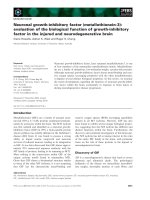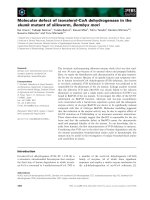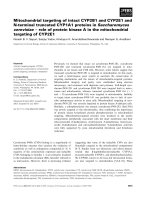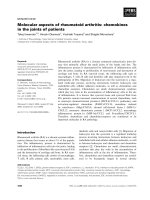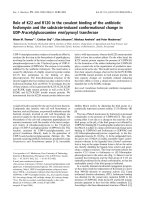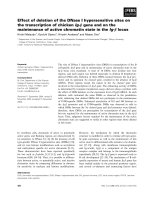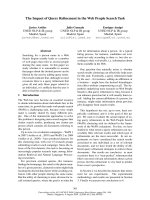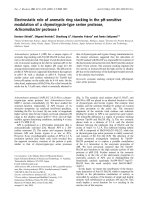University efl learners perceptions of mind mapping application in the pre speaking stage
Bạn đang xem bản rút gọn của tài liệu. Xem và tải ngay bản đầy đủ của tài liệu tại đây (738.71 KB, 90 trang )
MINISTRY OF EDUCATION AND TRAINING
VINH UNIVERSITY
-----------
PHAM THI KIM TUOI
UNIVERSITY EFL LEARNERS' PERCEPTIONS OF MIND
MAPPING APPLICATION IN THE PRE-SPEAKING STAGE
Major: Teaching English to Speakers of Other Languages (TESOL)
Code: 8.14.01.11
MASTER THESIS IN EDUCATION
Supervisor: Ngơ Đình Phương, Assoc. Prof. Ph.D.
Nghe An, 2018
STATEMENTS OF AUTHORSHIP
I certify that this thesis is my original work; it is based on my own research.
All sources used by me have been documented. No other person’s work has been
used without due acknowledgement and can be shown in the list of references. My
thesis has not been submitted to any other universities and institution wholly and
partially.
Nghe An, 2018
Author
Pham Thi Kim Tuoi
i
ACKNOWLEDGEMENTS
This thesis would not have been completed without the support of many
people.
First, and foremost I would like to express my deepest thanks my supervisor
Assoc. Prof. Dr Ngo Dinh Phuong for his assistance, encouragement and guidance.
Secondly, I would like to convey my thanks to all my students at Dong Nai
Technology University who have participated in this research, my lectures at the
Dong Nai Technology University and many others who helped me during my
study at DNTU.
Finally, I would like to express the warmest gratitude to my husband, children,
and parents for their support and understanding. I feel greatly indebted to them for
their essential help and encouragement
ii
ABSTRACT
Speaking skill is considered one of the most important factors when learning a
language. To develop the ability of speaking skills, mind map application in
teaching pre-speaking stage can do a great job. There are a variety of activities that
enhance students’ speaking ability. Drawing mind map activities are good ways to
encourage students to prepare well before they actually speak. This study aims at
investigating the use of mind map application in English speaking lesson at Dong
Nai Technology University to find out whether they are effectively used and
suitable to develop students’ speaking skills.
The aim of this study is to investigate how students perceive mind mapping
application in the pre-speaking stage at DNTU. The study based on a questionnaire
was used for 90 students from 3 classes at DNTU and interviews for fourteen
students were selected to participate in this study. Both qualitative and quantitative
methods were employed to analyze collected results and create a detailed
description of the real teaching context. The data is collected through
questionnaires, interviews and observation. By doing this, I can see the students’
attitudes towards mindmap technique in the pre-speaking stage.
Findings show that students have positive attitudes towards the use of
mindmap technique at the beginning of the speaking lesson. Using mind mapping
helps students in planning before their speaking, adopting a deeper level of
understanding of the speaking topics and promoting confidence in speaking. They
find that the mind map is very helpful to students in their the pre-speaking. They
realized English speaking skill plays an important role in their future jobs. This
study ends by discussing the important issues students perceiving the mind
mapping application in the pre-speaking stage at DNTU.
iii
The findings of the study are hoped to provide insights to the students, teachers
and curriculum designers to integrate mind mapping strategy in ESL (English as a
Second Language) speaking classes.
iv
TABLE OF CONTENTS
Chater 1: INTRODUTION ........................................................................................1
1.1 Rationale ..............................................................................................................1
1.2 Aims of the study .................................................................................................2
1.3 Research questions ..............................................................................................2
1.4 Problem statement:...............................................................................................3
1.5 The organization of the study ..............................................................................4
Chapter 2 ....................................................................................................................5
LITERATURE REVIEW AND THEORETICAL BACKGROUND.......................5
2.1 The overview of English speaking skill ...............................................................5
2.2 Difficulties in learning speaking skills ................................................................6
2.3 The shape of a speaking lesson ............................................................................7
2.3.1 Pre-speaking stages.....................................................................................8
2.3.2 While-speaking stage ..................................................................................8
2.3.3 Post-speaking stage.....................................................................................9
2.4 Problems with the speaking activity in the pre-speaking stage ..........................9
2.5 Factors affecting speaking skills in the pre-speaking stage ...............................11
2.6 Mindmap ............................................................................................................14
2.6.1 The definition of mind mapping ...............................................................14
2.6.2 The benefits of mind mapping for learning ..............................................16
2.6.3 The drawbacks of mind-mapping in the EFL classroom .........................20
2.6.4 Mind mapping technique is an effective learning tool .............................21
2.6.4.1 Clear structure ........................................................................................21
2.6.4.2 Personalisation .......................................................................................22
2.6.4.3 Creativity ...............................................................................................23
2.5.6.4 Motivation..............................................................................................25
v
2.6.5 The effective mind map application for language teaching and learning 26
2.7. Previous studies related to the research ............................................................30
2.7.1 Previous studies related to the pre-speaking skills ...................................30
2.7.2 Previous studies related to the mind mapping ................................................32
Chapter 3: METHODOLOGY .................................................................................36
3.1 The context of the study .....................................................................................36
3.1.1 The setting ................................................................................................36
3.1.2 Participants ...............................................................................................36
3.2 Scope of the study ..............................................................................................37
3.3 Methods of the study ..........................................................................................37
3.4 Instruments for data collection...........................................................................38
3.5 Study procedures ................................................................................................38
3.6 Data analysis ......................................................................................................39
3.6.1 Questionnaires ..........................................................................................39
3.6.2 Interview ...................................................................................................39
3.6.3 Class observations ....................................................................................40
Chapter 4 DATA ANALYSIS AND FINDINGS ...................................................41
4.1 Questionaires ......................................................................................................41
4.1.1 Data analysis from the questionaires ..............................................................41
4.1.2 Summary of the questionaires findings ....................................................50
4.2 Interview ............................................................................................................51
4.2.1 Data analysis from the interview ..............................................................51
4.2.2 Summary of the interview findings .........................................................55
4.3 Class observation ...............................................................................................56
4.3.1 Data analysis from the class observation..................................................56
4.3.2 Summary of the class observation ...........................................................58
Chapter 5 ..................................................................................................................59
vi
CONCLUSION ........................................................................................................59
5.1 Summary and conclusion ...................................................................................59
5.1.1 Summary of the study ...............................................................................59
5.1.2 Conclusion of the study ............................................................................60
5.2 Limitations of the study .....................................................................................61
5.3 Suggestions for further study .............................................................................61
5.3.1 Recommendations for teachers .................................................................61
5.3.2 Recommendations for students .................................................................62
REFERENCES.........................................................................................................63
APPENDICES .........................................................................................................68
Appendix 1: The survey questionnaire
Appendices 2: Bản điều tra khảo sát dành cho học sinh
Appendices 3: Interview questions
Appendices 4: Câu hỏi phỏng vấn
Appendices 5: Class observation checklist
vii
LIST OF GRAPHS
Graph 1: Student’s view of the importance of English speaking skill.
Graph 2: The difficulties of students take part in the pre-speaking stage.
Graph 3: Factors influence students’ attitudes related to the starting of speaking
lessons before using mindmap technique.
Graph 4: Students’ perceptions of mind mapping technique.
Graph 5: Mindmap activities get students involved in begin the speaking lessons
over the last 8 weeks.
Graph 6: Mind mapping helps students begin the speaking lessons.
Graph 7: Students satisfied towards brainstorm ideas using mind maps in the prespeaking lesson.
Graph 8: Students' impression of using Mind Mapping.
Graph 9: Students' attitudes towards using mind maps in the pre-speaking lesson.
Graph 10: Reasons for continuing using the mind map to begin the speaking lessons
in the coming time.
Table 11: Students’ views on the speaking lesson after applying mind maps in the
pre-speaking stage.
Table 12: Students’ attitudes towards the mind map technique applied in the prespeaking lesson.
Table 13: The student's point of view related to using of mind maps in the stage of
the lesson.
Table 14: Students’ attitudes towards the advantages of using mind mapping
strategy in the pre-speaking lesson.
viii
ABBREVIATIONS
DNTU
: Dong Nai Technology University
EFL
: English as Second Language
MM
: Mind map
T
: Teacher
Ss
: Students
ix
Chater 1
INTRODUTION
1.1 Rationale
In the process of industrialization and modernization in connection with the open
door policy of Viet Nam, learning English is becoming a need of work place that
most students are aware of the importance of it. Speaking skill plays an important
role in deciding the students’ future job which helps learners to have the confidence
to speak when seeking a job. But learners always find it is difficult to start the
speaking lesson. If students find the method boring, they will lose interest in
learning a language. The matter of learner’s attitude is acknowledged as one of the
most important factors that impact on learning a language (Fakeye, 2010). So how
to help students get more exciting at the beginning of the speaking lesson is still a
big question that needs to find out the answer for the teachers who teach English as
a second language. To get students' attention at the beginning of speaking lesson in
an effective way, researchers consider mind map. The use of mind map technique is
suggested as the best way of learning, out of the traditional way for students and
also the teachers in preparation for the new lesson. By applying mind maps in
learning, students can save more time, improve their speaking skill, remember the
new vocabulary and take notes, so they will not forget it.
On the one hand, the perception of students is considered as an important factor
influencing language performance and received considerable attention from both
first and second language researchers. The ability of students to master a second
language is not only influenced by the mental competence or language skills, but
also on the students’ attitudes and perceptions toward the target language (Abidin
1
et al., 2012). They also advocated that attitude concept could enhance the process
of language learning, influencing the nature of student’s behaviors and beliefs
toward the other language, its culture, and community, and this will identify their
tendency to acquire that language.
Learner’s perception of the mindmap's benefits is a massive thing, which holds an
important role in supporting students, for examples: plan the ideas, take notes,
prepare for the lesson before students actually speak. Studying about students'
perceptions about mindmap application is necessary. This study looks into figure
out the awareness of the students through using the mind map application in the
pre-speaking stage as one of the major affective factors for success in learning a
foreign language.
1.2 Aims of the study
The purpose of the study is to find out the perception of learners between
using the mindmap application at the beginning of speaking lesson to determine the
significance of the students’ attitudes and perceptions toward the studying of the
language.
The aim of the study is as follows:
- To determine the perception of students towards using the mindmap
application in the pre-speaking stage.
- To provide a classroom learning strategies for teachers of English to prepare
English speaking lessons at the Dong Nai Technology University.
1.3 Research questions
The study is to answer the following research questions:
1. What are DNTU students’ perceptions of using mind mapping in the prespeaking stage?
2
2. Does using mind mapping change DNTU students’ perceptions in the prespeaking lesson?
1.4 Problem statement:
Learning to speak English is one of the most difficult things most students
face in their learning. According to Vietnamnet.vn, 2011 when studying at lower
levels, middle school, students are accustomed to focusing on English grammar to
perform well in many written tests, many quizzes and speaking skills are often
forgotten. In the class. So after 7 or 10 years of studying English at school,
Vietnamese students do not speak English correctly. Due to the traditional teaching
methods that students stay passive in their lessons and lack of communication
environment to practice English, students gradually become uninterested in
learning English and are afraid to speak English. When studying at university,
students are provided with knowledge and practice for their future careers and
English speaking skills are also important to them. Students from the Dong Nai
University of Technology come from many parts of the country. Most of them have
no solid English background. They are not used to learning English to
communicate even though the goal of the English program at the Dong Nai
University of Technology is to help students gain better communication skills when
they complete their English language course. Accordingly, there is a great need to
improve students' speaking skills and to find out the difficulties students face so
teachers can have good strategies to encourage students to learn these skills. Thus,
the researcher uses mind mapping to improve student speech skills because mind
mapping techniques have many advantages, the main benefit is that you use both
halves of the brain to be easier to remember. Moreover, making the mind-map is
fun. It is a creative process and a natural way to organize your thoughts. Most
3
students like it because it is not boring. It will also save time because students will
memorize topic material much faster so it takes less time to teach them (Hofland,
2007).
1.5 The organization of the study
The thesis consists of the following main parts:
Chapter 1: Introduction presents the rationale and the scope of the thesis, defines
the aim of the study. The research questions is also mentioned in this part.
Chapter 2: Literature Review covers the concepts relevant to the study: theoretical
backgrounds of teaching speaking skills, the pre-speaking stage, and theory of mind
map application.
Chapter 3: Methodology in this chapter, the methodology of the study is described.
The informants such as perception of students at the Dong Nai Technology
University are mentioned.
Chapter 4: Finding and discussions present and discusses findings of the difficulties
in learning speaking skill at Dong Nai Technology University and some
suggestions for using the mind map to solve these problems.
Chapter 5: Conclusion summarizes the findings and addresses the shortcomings of
the study. It also gives suggestions for further researches and studies.
4
Chapter 2
LITERATURE REVIEW AND THEORETICAL BACKGROUND
This chapter focuses on the literature review and theoretical background of the
study. It includes theory background about speaking skill, stages of a speaking
activity, the pre-speaking stage, mind map application techniques and previous
studies related to the thesis will also be mentioned.
2.1 The overview of English speaking skill
According to Byrne (1976), “speaking is a two-way process between the speaker(s)
and the listener(s) involving the productive skill of speaking and the receptive skill
of understanding.” Brown (2001) indicates that the ability to speak a language can
show that a person can produce a conversation competently. Among the four macro
skills of English, Ur (1996) views that speaking is the most important because
speaking can show that a person can use the target language. Speaking skills helps
students acquire the main goal of learning English and also have great support for
other skills like listening skills, reading skills and writing skills. Speaking is
considered the main skill of a language (Nation, 2011) because it is the way to
communicate directly. Fiona Lawtie (2004): Speaking is fundamental to human
communication. In our daily lives, most of us speak more than we write. But
however, there are still many English teachers spend too much time on teaching the
student about reading and writing skills almost ignore speaking and listening skills.
Through speaking, people can easily convey ideas, thoughts and opinions (Torky,
2013) and also know how well speakers can perform in a language (CampbellLarsen, 2012). John (2001) theorized that English speaking performance has also
effected on the other English skills. When the speaking skill of students is good, it
5
means that they have more promotion to improve their other skills (reading, writing
or listening). Four skills will support each other. So their speaking skill will be
better day by day. Brown (1994) and Burns & Joyce (1997) have identified that
speaking skills are an interactive process of meaning building involved in the
production, receipt and processing of information. When participating in
communicative activities, the speaker should choose the correct vocabulary to
describe the things they want to say about, to rephrase or emphasize words to
clarify the description to produce the expected pattern of specific discourse
situations. According to Rahimi (2016), speaking is a productive skill that students
need a lot of practice and Ismaili and Bajrami (2016) also agree that students need
more chance to practice and apply English communicatively both inside and
outside the classroom to improve their fluency. Speaking skill is the first priority
for most English learners (Florez, 1999) because it helps learners acquire the main
goal of learning English and also have great support for other skills like listening
skills, reading skills and writing skills. Shumin (2002) points out that speaking
requires foreign language learners to use the language suitable to interact with the
society, which causes difficulty for learners to learn English speaking skills. Said
(2005 and 2008): Speaking skill is a complicated skill as it involves many
processes or operations working together. Speaking involve the linguistic, social,
psychological, cultural components.
2.2 Difficulties in learning speaking skills
Learning speaking has been one of the most difficulties that most students face
during their learning process. When studying at lower levels, secondary or high
school, students are accustomed to focusing on English grammar to perform well in
many kinds of writing tests, multiple choice tests and speaking skills are usually
neglected in the classrooms. Therefore, after 7 or 10 years studying English at
6
schools, Vietnamese students fail to speak English correctly (Vietnamnet.vn, 2011).
Because of the traditional teaching methods that students stay passive in the lessons
and have no communication environment for practicing English, students gradually
become not interested in learning English and fear to speak English.
In a study, Al-Saadi, Tonawanik & Harthy (2013) show that the majority of
students have the big problem in becoming proficient in even the fundamental
matters of speaking skills. Students from different places to encounter many
obstacles in learning speaking skills. This gradually discourages students from the
progress of English learning because they cannot take part in communicative
activities. According to Brown (1994), the elements in spoken language can make
speaking procedure easy or in some cases difficult. Students can have difficulties
with clustering, redundancy, reduced forms, colloquial language, stress, rhythm and
intonation because they do not have background knowledge nor practice at
previous stages of learning. Hosni (2014) lists four factors causing difficulties by
Ur (1996) which are inhibited: the fear of making mistakes of students; nothing to
say: the shortage of ideas to express; low or uneven participation: the domination
of good students in the large classrooms; mother tongue use: the tendency of using
the mother tongue among students. Besides that, motivation also has a close
relation to the difficulties in learning speaking. According to Littlewood (1981),
students can only develop their speaking skills when they have motivation and a
good chance to speak out their own ideas and opinions.
2.3 The shape of a speaking lesson
Three main stages of a speaking lesson are pre-speaking, while-speaking and post
speaking.
7
2.3.1 Pre-speaking stages
The stage prepares students to think about the topic or situation before they talk
about it. The tasks discussed before may be a discussion or brainstorming, where
students gather all their ideas about the topic; preparation vocabulary, where the
teacher pre-vocabulary, key to help understand; Predict where students guess what
they can learn. Good pre-requisites are also needed to integrate skills, which can be
heard and sometimes read. This stage should be kept short, about 10 minutes
equivalent to the presentation stage of a lesson, but giving enough time for students
to assimilate into what they are going to speak. Bygate, M believed that speaking is
a complex act with many different elements interacting to produce effective
communication. This might be due to lack of confidence, limited language or
vocabulary knowledge, but very often students do not know how to express their
ideas even in their mother tongue. Warm-up activities may be included at this
stage. If students find the method boring, they will lose interest in learning a
language.
2.3.2 While-speaking stage
This stage is the time for students to practice speaking. Teachers do not have to do
much work because students will work in jobs while individually or in pairs, in
groups. When working, they may experience some difficulties due to lack of
language; Thus, during this period, teachers can monitor and support weaker
students with their difficulties in completing replacement tasks. In addition, the
teacher also needs to assess how well students completed the task and whether they
were ready to go to the next stage or not.
8
Activities called communicators are really needed to be applied at this stage in
order to help students practice their speaking skills. They can be a player with a
role, a game or a discussion. Depending on the lesson and the classroom
conditions, the teacher will select and set appropriate activities for the student.
2.3.3 Post-speaking stage
After students have practiced speaking skills during this phase, they can perform an
extensive activity at this stage. This helps students get information or whatever they
have produced in the previous period and do something meaningful with it. The
latter task is usually "a transfer of information" - a type of exercise product where
they meet what they have just learned. They respond in a way that relates what they
have learned with their own experience. For example, if they talk about a worldfamous football player at this stage, they can talk or write about their favorite
player in the next stage. Writing is a very well integrated skill for this stage.
2.4 Problems with the speaking activity in the pre-speaking stage
It is not easy to get students to start talking in English at the beginning of the class.
How to encourage students to speak English and join speaking activities is the
worry of many teachers. Some problems with the speaking activity in the prespeaking stage. Talking exercises require a student to have all eyes on him and
introduction to a gathering of people can frequently deliver the student organize
dread. They may be stressed approximately, being criticized or afraid of losing
confront before the rest of the lesson.
Another common issue is that the students some of the time thinks they have
nothing to say on a specific point. In reality, they may be bored or feel that the
9
topic is unrelated to anything they know. On the off chance that this can be the
case, they will have no inspiration to talk other than the reality that they know they
ought to be partaking within the talking movement. Understudies regularly need
certainty in their talking capacity and feel they have efficiently dialect aptitudes to
specify precisely what they need to say.
There will always be dominant students in an English class, making it difficult for
more reserved students express themselves freely. Dominant students who interrupt
frequently or who constantly look for the teacher's attention tend to create an
environment in the EFL class where more timid students are quite happy to sit back
and watch the lesson unfolding instead of participating.
Learners who insist on using their mother tongue are students who lack confidence
and fear of being criticized, pointing out mistakes from the teacher, and so they
should be encouraged by other people to speak. Students must understand that they
do not speak their native language as this will waste valuable time between lectures
and slow progression.
The pre-speaking activities involve thought and reflection and provide
opportunities for students to plan and organize for speaking.
The pre-speaking in the other words warm up activities seem to be the main part of
every lesson, and so do on speaking lesson. And warm up activities are not an easy
thing to do, it is very hard to warm up the students in the class. During teaching, the
teachers always want to see many volunteer hands and the exciting attitudes of the
students in their lesson. So they will get more enjoyment and focus on the lesson. It
may spend a little time to warm up the motivation of the students, but it will bring a
lot of benefits later. Firstly, the first step, but play the main role in warm up the
motivation is the teachers have to have a good preparation for the lesson. Which is
not only save time in the lesson, but also lead the teacher what to do.
10
The goal for students to talk in advance is to enable them to create and explore
ideas for the topic through the activities. Course profiles provide a number of
forensic activities such as discussion, brainstorming, site thinking and graphic
organization, reading topic-related content, listening to speakers, ideas reflecting
the experience. Personalize and review the vocabulary needed for the topic.
Plan ahead or speak clearly so that participants first have time to prepare to plan
their speech with words, phrases and ideas. This can be achieved by planning the
removal at the end of the planning phase (Crookes, 2001: 372 and Ryo, 2005),
providing learners with the opportunity to plan ahead to encourage their internal
organization. The proposed solution and this result more smoothly than the actual
task performance. It also helps them deal with strains and communication
pressures. It was proved that speech rate increases and total pausing time decrease
by giving learners planning.
2.5 Factors affecting speaking skills in the pre-speaking stage
In English, there are four skills that need to be mastered by students: listening,
speaking, reading and writing. English communication is used mostly by people
from all over the different countries. Speaking is taking place everywhere and has
long become an integral part of our life as when someone says; He or she likes to
express their ideas, thoughts, and feelings by expressing language. Through
communication, he or she is sharing information with others. It's part of everyday
life that we consider it a good thing. On average, an average person can produce
more than a thousand words a day, while the sellers or politicians can produce more
words. It is natural and indispensable to say that forgetting the way we once
struggled to gain this ability until, that is, to learn to do it all again in one language.
Foreign. What then is related to speaking? The point that needs to be emphasized
first is that the production of speech takes place in real time, so basically it is linear.
11
Word by word, phrase by phrase. Similarly, at the level of say (that is, say the
equivalent of a sentence), the speech is produced verbally, in response to each word
and word, by the ordered product of the speaker. With interlocutor (Thornbury,
1988, pp. 1-2). Speaking is an active process of negotiating meaning and of using
social knowledge of the situation, the topic and the other speaker (Burn & Joyce,
1999, p. 14). Speaking is an active or productive skill. The target of speaking skill
is an ability to express ideas freely and spontaneously (Fahrurrazy, 2012, p. 79).
Bashir, Azeem & Dogar (2011) find out factors that have the influence on speaking
skills from both teachers and students. First, students’ speaking skills can be
affected by the language teachers use to give instructions in the classroom. When
they use English to give instructions, students can get used to listening to English
and remember the structures use. However, sometimes teachers can mother tongue
with complex problems to help students understand deeply and save time. Second,
teachers use techniques to encourage interaction between teachers and students in
the classroom, which can enhance students’ speaking skill while only a few
students answer the teachers in English because they are shy or unmotivated to
speak English in the classroom. The study by Khan and Ali (2010) also shows that
both teachers and students take the responsibility for poor speaking. Students do
not have enough time or are not given enough speaking exercises in their
classroom. Students are afraid of being scolded by the teachers or being laughed at
by their friends when they speak wrongly. Other factors that affect the students’
speaking ability are pedagogical tasks (Alhomaidan, 2014) and conversations
(Campbell-Larsen, 2012). Mostly in the classroom, teachers take good advantage of
the use of pedagogical tasks to help with students’ speaking skills by designing
interesting communicative activities to encourage students to speak English. In
language teaching, conversations play a vital role in developing students’ speaking
12
skills. Conversations are good ways to know someone’s ability to a language in
interaction because students will apply the target vocabulary and grammar
structures they have learned to talk with each other. In real life situations, a
language is mostly used in conversations that speakers will show their interaction
with each other
The factors that have the influence on speaking skills from students in the prespeaking stage, the teacher's role is to let students think about what they are going
to say before they speak. Teachers will have to set up pre-task and their clear
guidance are required. Previous studies have involved the preparation of wellspoken lessons. Gardiner, 1998; Fink, 1999 has shown many teachers today want to
change passive learning to active learning and to find better ways of gaging
students in the learning process. The relationship between students’ active
involvement and effective learning is so strong that the effectiveness of an
educational policy or practice is directly related to the capacity of that policy to
increase creativity in learning. So, when selecting among several teaching methods
or techniques, it is best to choose the ones that allow the learners to become more
involved. Anh (2014) stated that the most important thing to have a nice lesson is
preparation. If the teacher has good preparation, the lesson will be more exciting to
the students or if not it may get bored soon since every time the teacher get into the
class. By having a good preparation, it will save time for class, as if the teacher still
have time, they can let the children do whatever they want, in this way, the students
will have to pay more attention to your lesson than the other lesson because they
know your lesson always has leftover time and they can take a break before prepare
for another lesson but still have a depth understand what the teacher said.
By using mind mapping to prepare for learning, it can be very helpful. Many
studies have improved the benefits of mind mapping. In this study “Student’s
13
perception of mind mapping in Problem-based learning” Mindmap is very helpful
in helping the students in summarizing the ideas, which is also useful in receiving
the reflection and recall. Most of the students realize that using mind map can help
them increase the student achievements. Based on the result of this study, the mind
map can be seen that is an effective tool for teachers to use during their teaching.
This is another way of learning in the traditional way in research like "chalk and
talk" today in Mind Maps as a classroom exercise. There are many benefits that
mind map will bring you in the research results. Gardner (1985) was emphasized
the concern about the learners’ attitudes towards the target language. He stated that
the learners’ attitudes towards learning another language play a key role in
enhancing and motivating them to learn that language. Mind mapping will help
students remember the content of their speech through photographs, they will be
more confident, do not worry if they forget the content. It also helps students save
time in learning, they do not have to write a long paragraph about the presentation,
they just have to write the main ideas and draw funny pictures to memorize it.
2.6 Mindmap
2.6.1 The definition of mind mapping
Mind-map, invented and copyrighted by Tony Buzan, is a technique of representing
information in a visual way by demonstrating the connections among key concepts
and ideas (Buzan & Buzan, 1993, p. 93). Mapping can be a thing that makes a
different understanding think about and the professors teach the course material.
Mind Mapping is a diagram that can be used to outline visual information. You can
think of a mind map as a large brainstorming web, where a central word or idea
branches out into related subjects. When ideas are identified and linked together,
14
you can see how concepts connect to one another in order to better understand what
you are trying to study.
Students can improve their ideas as mind maps work well as an effective visual
design that enables students to clearly see the relationship between ideas, and
consequently encourages them to group certain ideas together according to their
similar characteristics as they proceed (Padang & Gurning, 2014). Through mind
mapping, one can develop their ability in memorizing, brainstorming, learning, as
well as creativity. There are seven steps in creating mind mapping (Buzan, 2005,
pp. 15-16) as follows:
1. Start at the center of the paper and put it horizontally. It does so as starting from
the center will provide a free thinking to the way of thinking mind and also follows
the natural rule.
2. Use a picture or photos of the central ideas. The saying “A picture is worth a
thousand words” may be a cliché, but it is true. The pictures will help us focus, and
activate our brain.
3. Use colors because color is as interesting as pictures of our brain that are able to
trigger thinking.
4. Draw a thick line out from the center and write an idea associated with the topic.
Then draw thin lines from the thick line and write ideas associated with it. Continue
to map until any more ideas cannot be thought of.
5. Use a curve line, not a straight line. Because the straight line will make our brain
bored.
6. Use one word per line. Since each word has an enormous number of
associations, and this rule allows each one more freedom to link to other
associations in our brain.
15


